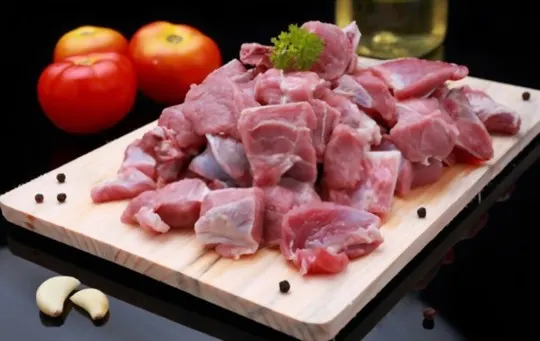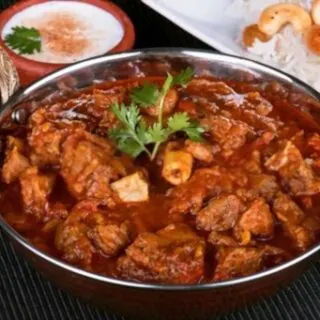Many people may have heard of the term ‘mutton’ before, yet few truly understand what it is and, more importantly, what it tastes like.
Most associate mutton with being an exotic form of meat that requires special recipes to bring out its full flavor; however, this couldn’t be further from the truth!
In reality, mutton is a type of meat that can easily be prepared in a variety of ways – whether you prefer roasting or smoking.
In this comprehensive guide on all things related to mutton, we will explore exactly what makes this unique type of meat so flavorful and give insights into how best to prepare it.
Here we go — buckle up for a delicious ride through the world of juicy roast mutton!
What is Mutton?

Mutton comes from the meat of mature sheep that are over a year old.
The meat is commonly used in Middle Eastern, Mediterranean, and Indian cuisine and is known for its distinctive flavor and texture.
Mutton has a richer flavor compared to lamb meat, which is more tender and has a milder taste.
This is because the sheep that produce mutton have had more time to develop and accumulate more fat, which adds to the meat’s flavor and tenderness.
Mutton can have a slightly gamy taste and a chewy texture.
The meat’s flavor can also be affected by how it was prepared and cooked.
When cooked properly, the meat is flavorful and enjoyable to eat.
Mutton is a nutritious meat that is high in protein and iron.
It is also lower in fat and calories than beef, making it a healthy alternative.
Pro Tip: When cooking mutton, marinate it overnight for better flavor and tenderness.
What Does Mutton Taste Like?

Mutton is meat from mature sheep, ideally aged for several weeks to improve its flavor and texture.
The taste of mutton varies depending on the age, diet, and breed of the sheep, as well as the cooking method used.
Generally, Mutton has a stronger and richer flavor than lamb, with a firmer texture and a more intense “meatiness.
” This flavor is often described as gamey, earthy, or grassy.
Some people find it too overpowering, while others enjoy its bold and complex taste.
Mutton is best suited for slow-cooking dishes like stews, curries, and roasts, where its strong flavor can complement and enhance other ingredients.
Pro tip: If you are new to mutton, start with a slow-cooked dish to allow the meat’s flavors to blend together and mellow out.
Factors that Affect the Taste of Mutton

Mutton is the meat of mature sheep that are about three years old.
The taste of mutton depends on various factors, including the sheep’s breed, age, diet, and the cut of meat.
Here are the factors that affect the taste of mutton:
- Breed: Different sheep breeds have different muscle structures, fat content, and taste. For instance, mutton from Dorset and Suffolk sheep generally has a milder and sweeter taste than that from other breeds.
- Age: The age of the sheep at the time of slaughter affects the flavor of its meat. Younger sheep have more tender and mild-flavored meat than older ones, which generally have tougher, gamier meat.
- Diet: A sheep’s diet affects the taste of its meat. Sheep that graze on grass have leaner and more flavorful meat compared to those fed on commercial grain and concentrates.
- Cut of meat: The taste of mutton also varies by the cut of meat. For example, leg and loin cuts tend to be more tender and mild-tasting compared to shoulder and rib cuts that are tougher and more flavorful.
Pro tip: To enhance the flavor of mutton, it is best to cook it slowly at low temperatures.
This allows the fat to render and infuse the meat with its flavors, resulting in a more tender and flavorful dish.
1 – Age
Mutton refers to meat that comes from an adult sheep that’s typically over two years old.
The meat is characterized by its strong flavor and dense texture.
The taste of mutton is often likened to a mix of lamb and beef, with a strong gamey flavor that intensifies as the animal ages.
Mutton can be prepared in a variety of ways, including grilling, roasting, and slow-cooking.
The meat is commonly used in stews and curries, due to its ability to absorb flavors and spices easily.
When purchasing mutton, it’s essential to look for tender cuts, such as the loin, leg, and ribcage.
The meat should be a rich red color and not have a pungent odor.
When cooked correctly, mutton can be a flavorful and satisfying addition to any meat dish.
Pro Tip: If you’re hesitant about cooking with mutton, try marinating the meat in acidic ingredients, such as vinegar or lemon juice, to help tenderize and mellow out the strong flavor.
2 – Diet
Mutton is the meat obtained from adult sheep, as opposed to lamb, which refers to the meat from young sheep.
The taste of mutton is stronger and richer than lamb and has a more complex flavor profile.
Mutton contains more fat and connective tissue, which makes it perfect for slow-cooking methods such as stewing, braising, or roasting.
The meat is darker and has a more robust flavor, and the aroma is earthy and slightly gamey.
If you’ve never tried mutton, it’s worth experimenting with some recipes to see how it fits with your palate.
Mutton curry, roasted leg of mutton, and shepherd’s pie with mutton are some classic dishes that can help you explore the unique taste of this meat.
3 – Cooking Method
Mutton is the meat from a mature sheep, typically over two years old.
It has a stronger and more robust flavor than lamb and a tender, juicy texture when cooked correctly.
Cooking methods for mutton vary depending on the cut of meat, but some popular options include roasting, grilling, and slow-cooking.
Mutton has a distinct “gamey” taste that some people find too strong, while others enjoy the rich, savory flavor profile.
To balance the strong taste of mutton, it is often paired with bold and aromatic spices like cumin, coriander, and garam masala.
When cooked well, mutton is a delicious and flavorful addition to stews, curries, and biryanis.
How to Cook Mutton to Enhance its Flavor?

Mutton is meat from mature sheep that is over a year old.
It has a strong, rich, and gamey flavor, which can be enhanced through proper cooking techniques to make it more flavorful and tender.
Here are some tips for cooking mutton to enhance its flavor:
- Marinate the meat for at least an hour before cooking to tenderize it and add flavor.
- Slow cooking mutton is key to breaking down the proteins and making it tender. A slow cooker or a low flame will do the trick.
- Spices like cumin, black pepper, coriander, and cinnamon complement the robust flavor of mutton.
- Pair mutton with acidic ingredients like lemon, vinegar, or yoghurt to cut through its gamey flavor.
Remember that overcooking can make mutton tough and chewy, so use a meat thermometer to check for doneness.
Allow it to rest for a few minutes before serving to let the juices settle.
Pro tip – If you’re looking for a more subtle flavor, opt for lamb meat which is from younger sheep less than a year old.
Is Mutton Healthy?

Mutton is the meat of domestic sheep that are older than one year of age.
The taste of mutton is stronger and richer than lamb, with a distinct gamey flavor that is often likened to beef.
If you’re looking for a lean, protein-filled meat that is packed with essential vitamins and minerals, mutton is a great option.
It is a good source of iron, zinc, and vitamin B-12, making it a healthy choice for those who follow a low-carb or high-protein diet.
Mutton is also rich in Omega-3 fatty acids, which have been shown to improve heart health and reduce inflammation.
Contrary to popular belief, mutton is not an unhealthy or fatty meat.
In fact, it is often leaner than beef and can be cooked in a variety of ways, including grilling, roasting, stewing, and braising.
Where to Buy Mutton and How to Store It?
Mutton is a type of meat obtained from mature sheep that are more than a year old.
It has darker meat and a stronger flavor compared to lamb, and the texture is generally tougher.
When it comes to taste, some people might find it gamy or earthy.
However, it is loved by many for its distinctive flavor and aroma that make it a unique addition to a wide array of dishes.
If you are planning to buy mutton, you can opt for local meat shops or online stores that sell fresh or frozen mutton.
It is important to ensure the freshness of the meat by checking its color, texture, and smell before purchasing.
When storing mutton, keep it in an airtight container or wrapped in a plastic sheet, and store it in the refrigerator at a temperature of 40°F or below.
Mutton can last up to three days in the refrigerator and up to six months in the freezer, depending on the cut and packaging.
Pro tip: Marinating mutton can help in tenderizing the meat and reducing the strong flavor.
Conclusion
In conclusion, mutton is the meat of an adult sheep that is over a year old, with a more intense flavor and firmer texture than lamb.
Mutton has a unique and distinct taste that can be described as gamey, earthy, and slightly sweet.
It is important to note that mutton is not as widely consumed as lamb or beef in some regions, but it has a special place in many traditional cuisines around the world due to its rich flavor and nutritious value.
Mutton can be cooked in various ways, including grilling, roasting, slow-cooking, and stewing, and pairs well with bold flavors and spices.
If you haven’t tried mutton yet, I highly recommend giving it a chance and experimenting with different recipes to discover its unique and delicious flavor.

What Does Mutton Taste Like? A Comprehensive Guide
Ingredients
- Mutton
- Ingredients from your selected recipes
Instructions
- Select ingredients that work well together.
- Use a recipe or method that will enhance their natural taste.
- Taste and adjust the recipe as needed to achieve the desired flavor.

Carrie is a food writer and editor with more than 15 years of experience. She has worked for some of the biggest names in the food industry, including Bon Appétit, Food & Wine, and Martha Stewart Living.
As the Editor in Chief of IntroChicago.com, Carrie oversees all of the content on the site. She also manages the team of contributing writers and editors, who help to create delicious recipes, helpful tips, and informative articles that you’ll find on the site.
A native of the Chicago area, Carrie is passionate about all things food. She loves trying new restaurants and experimenting with new recipes in her kitchen. She’s also a graduate of the Culinary Institute of America, so she knows a thing or two about food!
